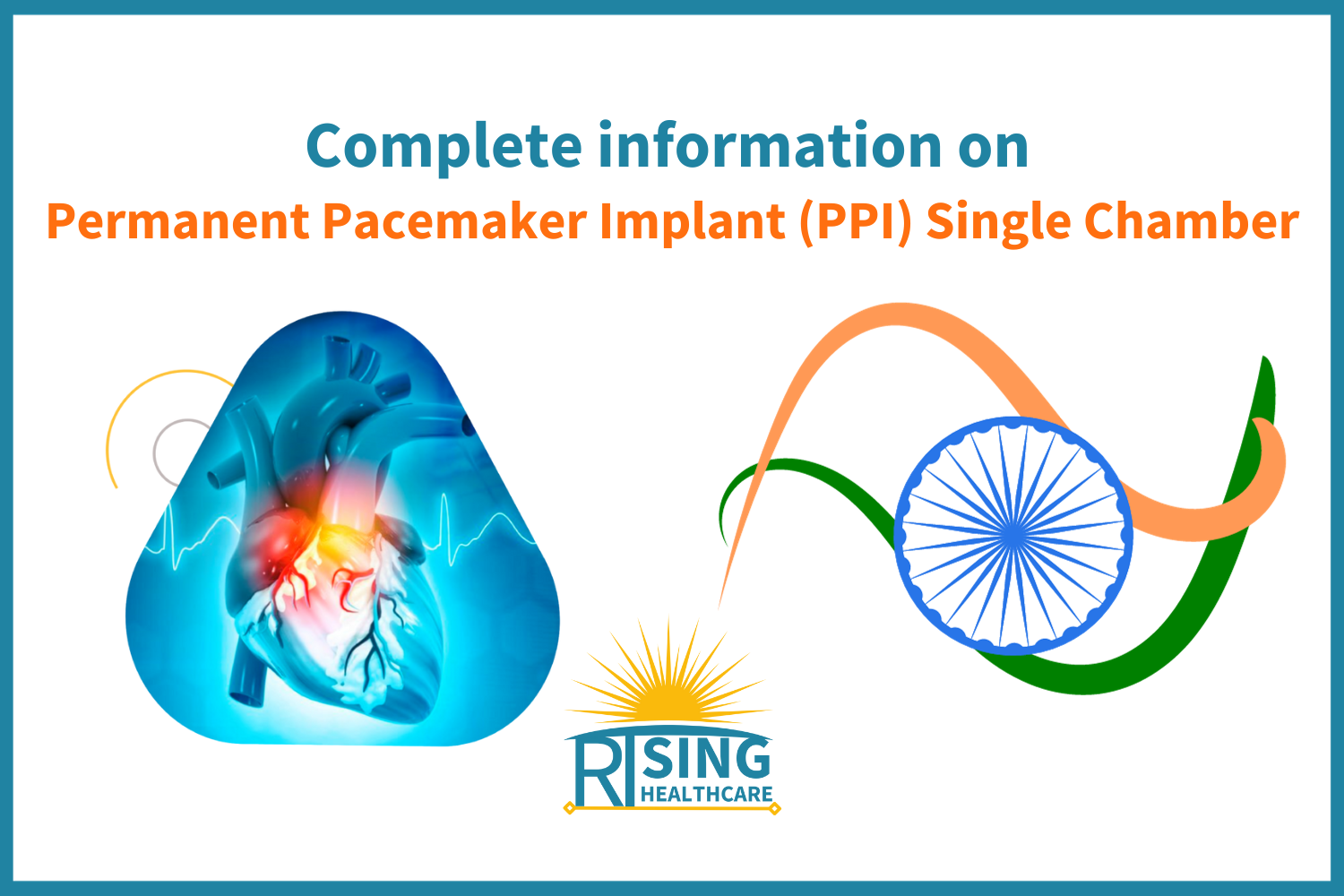
Understanding Permanent Pacemaker Implant (PPI) – Single Chamber
Contents
Permanent Pacemaker Implant (PPI) Single Chamber
When it comes to maintaining a healthy heart, medical advancements have played a significant role in enhancing the quality of life for countless individuals. One such innovation is the Permanent Pacemaker Implant (PPI) – Single Chamber. In this comprehensive guide, we will demystify the concept of a single-chamber permanent pacemaker implant and delve into its working, indications, benefits, and the entire implantation process. So, if you or a loved one is facing the possibility of getting a single-chamber PPI, read on to gain a clear understanding of what to expect.
What is a Permanent Pacemaker Implant (PPI) - Single Chamber?
A Permanent Pacemaker Implant (PPI) – Single Chamber is a medical device used to regulate and control the rhythm of the heart. It is commonly recommended for individuals who experience heart rhythm disturbances, also known as arrhythmias. These arrhythmias can cause the heart to beat too slowly, too fast, or irregularly, leading to symptoms such as dizziness, fatigue, and even fainting.
The single-chamber pacemaker, as the name suggests, is a type of pacemaker that has only one lead (a wire) placed either in the right atrium (the upper chamber of the heart) or the right ventricle (the lower chamber of the heart). The placement of the lead depends on the specific condition being treated.
How Does a Single-Chamber Permanent Pacemaker Work?
A single-chamber permanent pacemaker functions as an artificial electrical system for the heart. It consists of two main components: the generator and the lead.
- Generator: The generator is a small, battery-powered device that generates electrical impulses. It is implanted under the skin, usually in the upper chest area, just below the collarbone. The generator’s battery can last for several years, depending on how often it needs to send electrical signals to the heart.
- Lead: The lead is a thin, insulated wire that carries the electrical impulses from the generator to the heart muscle. In the case of a single-chamber pacemaker, there is only one lead, which is positioned in either the atrium or ventricle of the heart. When the pacemaker senses that the heart’s natural electrical signals are not working correctly, it sends electrical impulses through the lead to stimulate the heart muscle and regulate its rhythm.
The pacemaker constantly monitors the heart’s activity and adjusts the pacing rate as needed to maintain a steady and healthy heart rate. It ensures that the heart beats at an appropriate rate, preventing it from going too slow (bradycardia) or too fast (tachycardia).
Indications for Single-Chamber Permanent Pacemaker Implantation
Now that we understand how a single-chamber permanent pacemaker works, let's explore the common indications that lead to its implantation:
- Bradycardia: Bradycardia is a condition characterized by a slow heart rate, typically less than 60 beats per minute. It can lead to symptoms like dizziness, fatigue, and fainting. A single-chamber pacemaker is often recommended for individuals with bradycardia to ensure their heart maintains an adequate rhythm.
- Heart Block: Heart block is a condition where there is a delay or blockage in the electrical signals traveling from the atria to the ventricles. This can result in a slow or irregular heartbeat. Single-chamber pacemakers can help restore proper heart rhythm in cases of heart block.
- Sick Sinus Syndrome: Sick Sinus Syndrome refers to a group of heart rhythm disorders where the heart’s natural pacemaker, the sinoatrial (SA) node, does not function correctly. This can lead to periods of slow heart rates alternating with fast heart rates. A single-chamber pacemaker can help stabilize the heart rate in individuals with this condition.
- Tachy-Brady Syndrome: Some individuals experience both fast heart rates (tachycardia) and slow heart rates (bradycardia). In such cases, a single-chamber pacemaker may be implanted to manage the bradycardia component of the condition, while other treatments address the tachycardia.
Benefits of Single-Chamber Permanent Pacemaker Implantation
The implantation of a single-chamber permanent pacemaker offers several key benefits to individuals with heart rhythm disorders:
When it comes to maintaining a healthy heart, medical advancements have played a significant role in enhancing the quality of life for countless individuals. One such innovation is the Permanent Pacemaker Implant (PPI) – Single Chamber. In this comprehensive guide, we will demystify the concept of a single-chamber permanent pacemaker implant and delve into its working, indications, benefits, and the entire implantation process. So, if you or a loved one is facing the possibility of getting a single-chamber PPI, read on to gain a clear understanding of what to expect.
What is a Permanent Pacemaker Implant (PPI) – Single Chamber?
A Permanent Pacemaker Implant (PPI) – Single Chamber is a medical device used to regulate and control the rhythm of the heart. It is commonly recommended for individuals who experience heart rhythm disturbances, also known as arrhythmias. These arrhythmias can cause the heart to beat too slowly, too fast, or irregularly, leading to symptoms such as dizziness, fatigue, and even fainting.
The single-chamber pacemaker, as the name suggests, is a type of pacemaker that has only one lead (a wire) placed either in the right atrium (the upper chamber of the heart) or the right ventricle (the lower chamber of the heart). The placement of the lead depends on the specific condition being treated.
How Does a Single-Chamber Permanent Pacemaker Work?
A single-chamber permanent pacemaker functions as an artificial electrical system for the heart. It consists of two main components: the generator and the lead.
- Generator: The generator is a small, battery-powered device that generates electrical impulses. It is implanted under the skin, usually in the upper chest area, just below the collarbone. The generator’s battery can last for several years, depending on how often it needs to send electrical signals to the heart.
- Lead: The lead is a thin, insulated wire that carries the electrical impulses from the generator to the heart muscle. In the case of a single-chamber pacemaker, there is only one lead, which is positioned in either the atrium or ventricle of the heart. When the pacemaker senses that the heart’s natural electrical signals are not working correctly, it sends electrical impulses through the lead to stimulate the heart muscle and regulate its rhythm.
The pacemaker constantly monitors the heart’s activity and adjusts the pacing rate as needed to maintain a steady and healthy heart rate. It ensures that the heart beats at an appropriate rate, preventing it from going too slow (bradycardia) or too fast (tachycardia).
Indications for Single-Chamber Permanent Pacemaker Implantation
Now that we understand how a single-chamber permanent pacemaker works, let’s explore the common indications that lead to its implantation:
- Bradycardia: Bradycardia is a condition characterized by a slow heart rate, typically less than 60 beats per minute. It can lead to symptoms like dizziness, fatigue, and fainting. A single-chamber pacemaker is often recommended for individuals with bradycardia to ensure their heart maintains an adequate rhythm.
- Heart Block: Heart block is a condition where there is a delay or blockage in the electrical signals traveling from the atria to the ventricles. This can result in a slow or irregular heartbeat. Single-chamber pacemakers can help restore proper heart rhythm in cases of heart block.
- Sick Sinus Syndrome: Sick Sinus Syndrome refers to a group of heart rhythm disorders where the heart’s natural pacemaker, the sinoatrial (SA) node, does not function correctly. This can lead to periods of slow heart rates alternating with fast heart rates. A single-chamber pacemaker can help stabilize the heart rate in individuals with this condition.
- Tachy-Brady Syndrome: Some individuals experience both fast heart rates (tachycardia) and slow heart rates (bradycardia). In such cases, a single-chamber pacemaker may be implanted to manage the bradycardia component of the condition, while other treatments address the tachycardia.
Benefits of Single-Chamber Permanent Pacemaker Implantation
The implantation of a single-chamber permanent pacemaker offers several key benefits to individuals with heart rhythm disorders:
- Symptom Relief: One of the primary benefits of a single-chamber pacemaker is symptom relief. It helps alleviate symptoms associated with bradycardia, heart block, and other rhythm disturbances, allowing patients to enjoy a better quality of life.
- Improved Quality of Life: With a properly functioning pacemaker, individuals can engage in their daily activities without the fear of experiencing sudden fainting spells or debilitating fatigue.
- Lifesaving Device: In some cases, a single-chamber pacemaker can be a lifesaving device. It ensures that the heart maintains a minimum acceptable rate, preventing dangerous drops in heart rate that could lead to cardiac arrest.
- Customized Programming: Single-chamber pacemakers can be programmed to suit each patient’s specific needs. Cardiologists can adjust the pacing rate and other settings to optimize heart function.
The Single-Chamber Permanent Pacemaker Implantation Process
The implantation of a single-chamber permanent pacemaker is a well-established medical procedure that is typically performed by a cardiologist or an electrophysiologist (a specialist in heart rhythm disorders). Here is an overview of the implantation process:
- Pre-Procedure Assessment: Before the procedure, the patient undergoes a thorough evaluation, which may include a physical examination, electrocardiogram (ECG), and other cardiac tests. These tests help determine the appropriate type of pacemaker and the optimal location for lead placement.
- Anesthesia: The procedure is usually performed in a sterile operating room. Local anesthesia is administered to numb the area where the pacemaker will be implanted, typically in the upper chest.
- Lead Placement: A small incision is made in the upper chest, and the lead is inserted through a vein into the heart. The lead’s position depends on the specific condition being treated, as mentioned earlier.
- Generator Implantation: Another small incision is made to create a pocket beneath the skin, usually in the upper chest area. The generator is placed in this pocket, and the lead is connected to it.
- Testing and Programming: Once the pacemaker is in place, it is tested to ensure it is working correctly. The cardiologist or electrophysiologist programs the pacemaker to the patient’s specific heart rate needs.
- Closure: The incisions are closed with sutures, and a sterile dressing is applied over the area.
- Post-Procedure Monitoring: After the implantation, the patient is monitored for a short period in a recovery area to ensure there are no immediate complications. Most patients can go home the same day or after a brief hospital stay.
Recovery and Post-Implantation Care
Recovery after a single-chamber permanent pacemaker implantation is typically smooth and well-tolerated. Patients are advised to follow these post-implantation care guidelines:
- Avoid Heavy Lifting: Patients are usually advised to avoid heavy lifting and strenuous activities for a few weeks to allow the incisions to heal properly.
- Medication: Patients may be prescribed medications to prevent infection and manage pain following the procedure.

